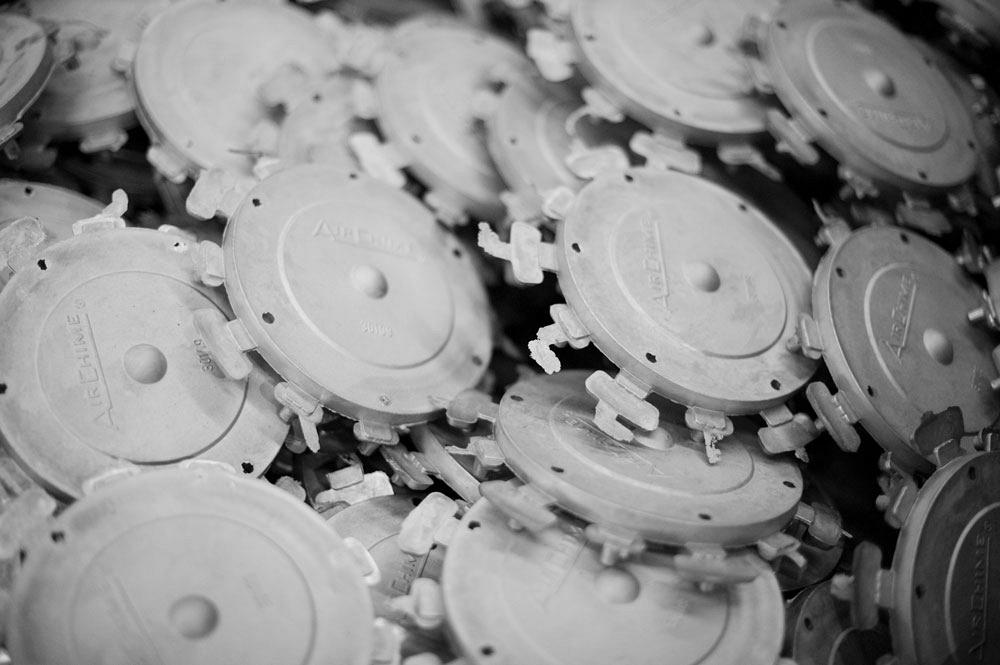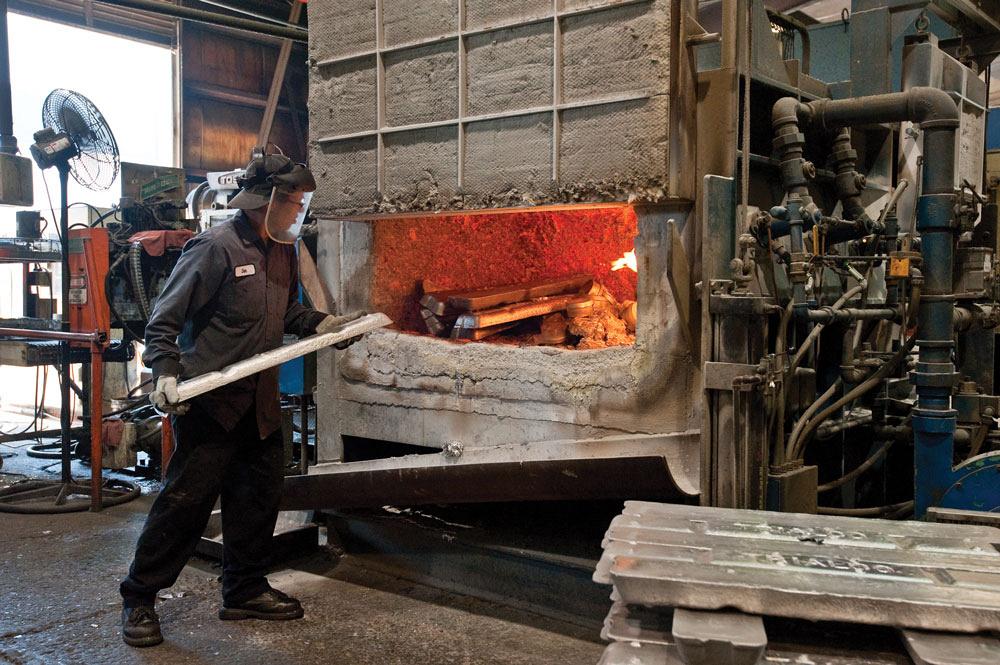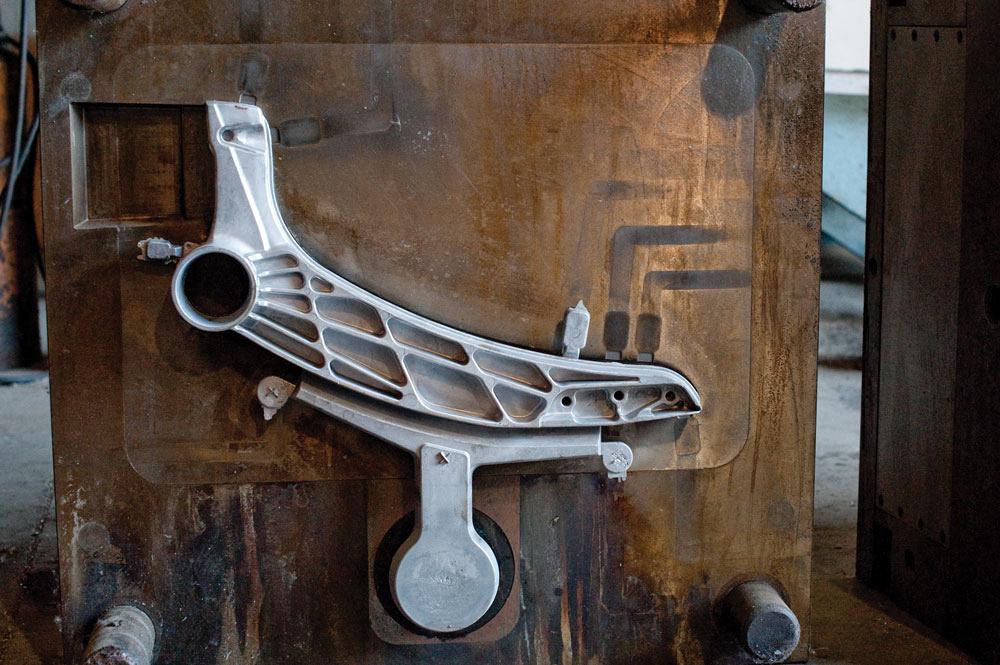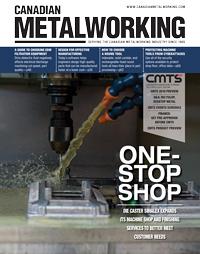Associate Editor
- FMA
- The Fabricator
- FABTECH
- Canadian Metalworking
Die caster sees productivity gains with expanded machining capabilities
Simalex has transformed itself into a one-stop shop for customers’ die casting needs
- By Lindsay Luminoso
- October 1, 2019
- Article
- Metalworking

With four generations of die casters, Simalex has transformed over the years to meet the increasing demands of the North American die casting market.
According to the North American Die Casting Association (NADCA), die castings are among the highest-volume, mass-produced items manufactured by the metalworking industry, and are found in thousands of consumer, commercial, and industrial products.
High-pressure die casting is a process that can produce complex geometries with a high degree of accuracy and repeatability. Components can be produced to strict specifications, with smooth or textured surfaces, and they are suitable for a variety of finishing options.
In Canada, particularly the eastern region, die casting is heavily tied to the automotive sector. However, in Western Canada die casters tend to be more generalists, taking on both short- and long-run production projects for a wide range of industry applications.
Simalex, a high-pressure die casting company located in Langley, B.C., has been doing just that for just over half a century. With four generations of die casters, the shop has transformed over the years to meet the increasing demands of the North American die casting market.
Fred Lyhne Jr., the CEO and director of engineering of Simalex, has been in the business most of his life. His grandfather, Alex, founded the company in 1962 in his backyard in Surrey, B.C. After only four years, Alex convinced his son, Fred Sr., a die caster by trade, to join the company and move Simalex into the die casting world.
Fred Jr., who began his die casting career helping his father on weekends, eventually took over the company with his son, Freddy. Fred Jr. has a degree in mechanical engineering in addition to being a Red Seal machinist and tool and die maker and focuses on this aspect of this business. His son Freddy is a certified Red Seal machinist and is focused on operations and production. Together, the father-son duo has expanded the company’s automated manufacturing and finishing capabilities, turning it into a one-stop shop for all its customers’ die casting needs. Simalex also offers full-service toolmaking, complete with engineering and design for manufacturing services.
“We are a small company in terms of the quantity of our staff, but we are highly automated,” said Fred Jr. “Automating the shop has given us the flexibility to adjust production runs from short to long and switch to different alloys when needed. Our flexibility and limberness are what make us special.”
Die Casting
On the shop floor, Simalex has cold-chamber and hot-chamber Toshiba die casting machines ranging in size from 300 to 900 U.S. tons.
Cold-chamber die casting is a preferred manufacturing process for metals that have high melting points, and it’s used by most of the top parts manufacturers in the industry. Typically, these metals include alloys of aluminum, brass, and copper. Cold-chamber machinery requires additional equipment—usually an outside furnace and a ladle to pour the metal into the machine—for die casting. Molten metal must be ladled into the chamber directly, either through a ladle system or manually. Once the molten metal is loaded to a sufficient volume, it is injected into the die through a high-pressure hydraulic plunger. Pressure requirements for cold-chamber castings typically are higher than those for hot-chamber die castings.
Hot-chamber machinery contains the alloy melting pot as part of the machine itself and uses a gooseneck to inject material from the pot into the die. Internals of the machine pair the plunger and port to control how much molten metal is injected into the die. When the port seals, the metal rests in the cavity to cool and solidify. Next, the plunger retracts and the casting itself can be removed once the die opens. This design allows hot-chamber die casting to be a continuous process. Because the melting pot is internal, hot-chamber machinery is used for materials with lower melting points. The alloys are limited to materials that won’t erode or dissolve the metal of the machine when put under heat or high pressure. Typical materials used in hot-chamber die casting are zinc, lead, and magnesium alloys. For hot-chamber, the shop primarily focuses on zinc alloys, particularly Zinc Alloy 3, 5, and 8.

On the shop floor, Simalex has cold-chamber and hot-chamber Toshiba die casting machines ranging in size from 300 to 900 U.S. tons.
It’s this continuous process that makes die casting a great option for high-volume production. Depending on the part configuration, CNC machining can be quite an expensive option, not to mention time-consuming.
“What would typically take 10 to 15 minutes to machine, we can die cast in about 30 seconds,” said Fred Jr. “It tends to be a much less expensive process with a high level of repeatability. Now there are some concessions with die casting, particularly when it comes to strength, as we are not able to heat-treat our alloys at this time, but it is mostly cost and volume that drive the demand.”
He gives the example of a 300,000 part run. Fred Jr. estimates that there are not enough shops in mainland Vancouver that could handle that volume. However, it’s perfectly suited for die casting, and Simalex could easily handle it. With such large runs, streamlining production is necessary. This is why Simalex has configured its shop floor into die cast machine cells.
“The die casting machine cells have all the necessary trimming operations,” he said. “We have robotic spray, robotic extraction, cooling conveyors, and a trim press, all within the cell. From there the component goes on to whatever secondary process is required. In some cases it goes to our CNC machining department. Other times it just goes for some additional deburring or inspection, or even right into vibratory finishing or shotblasting, followed by chromate, anodizing, powder coating, or assembly.”
In the past year, the company has focused on bringing some of its outsourced services in-house, particularly its machining services. One of the reasons is that massive amounts of inventory must be kept on its suppliers’ floors to accommodate the JIT delivery requirements of its customers.
Machine Shop
“Up until this year we had engaged and utilized the capacity, upwards of 50 per cent, of the qualified machine shops able to supply us in the local area,” said Fred Jr. “It became really taxing to control delivery and quality.”
He explained that being unable to control deliveries in the time frame the company required at a specific price was a big challenge, and although the company didn’t have many quality control issues, it was still on the top of Fred’s mind.
“We do have controls in place for quality, especially because our service shops are an extension of our company and are subject to quality audits, but it's still not our company,” said Fred Jr. “We have always had a CNC machining department in-house, but recently we decided to expand on that. We bought two new additional CNC machining centres with 4-axis capability this year and are continuing to expand on our capacity with the idea of bringing a lot of that machining back in-house.”
Beyond the CNC machines, the company has a number of manual machines, including tapping machines, drills, presses, punches, and a grinding station. But it is always looking for new opportunities for investment.
“We have an overall goal to see how far we can push our capacity,” said Freddy. “We are trying to figure where is the best place to put our investment. There is so much equipment available and so many options for where we could invest. I think one of our next steps is to try and acquire a chromate and powder coat line. I’d really like to see us focus on moving away from subcontracting to third-party suppliers like we’ve done with our machine shop. There is so much cost saving, bringing coatings and other services in-house is a huge advantage.”
With the new CNC machines, the company recently hired a Red Seal CNC machinist to really focus on this side of the business and fill the machines up to capacity. Freddy noted that the shop has struggled to find skilled workers to operate the machinery, so Simalex is constantly on the lookout for new employees with a good work ethic and an eagerness to learn.
Looking Forward
Incorporating automation on the shop floor has helped Simalex deal with the labor shortage.
“Robotic deburring is something that I would really like to have on the shop floor as soon as possible,” said Fred Jr. “Sometimes using a robot rather than a CNC machine for simple machining is the better way to go. Sometimes with specific deburring requirements like trim finish, we could use a robotic arm rather than a human operator to perform that task. We are certainly looking for faster, improved robots on the shop floor.”
Fred Jr. explained that last year was tough for the company, having lost 12 of its longtime employees to retirement. Not only was it challenging to find workers to replace them, but it left a brain-drain in the shop. Developing workcells and automating the shop floor, along with updated ERP, enable the company to place new, less experienced workers in the cells because the equipment controls the process speed and consistency with respect to manufacturing standards specified by its customers.
“There are few die casters near us, so there is limited training and schooling offered for die casting,” said Freddy, who is focused on developing in-house training programs, with the help of NADCA, for new employees.
It can take upwards of six months for new employees to get up and running basic die casting machines and years to be competent in troubleshooting defects out of castings, which is why losing longtime employees was such a challenge.
“Looking forward, down the road I would like to get busy with some acquisitions of companies that can support our supply chain so that we can offer all the services required but with full control of quality and delivery,” said Fred Jr. “Currently our growth is being limited by our suppliers’ capacity to produce the value add needed by our customers. As we conclude this current business cycle, I do believe that Simalex has positioned itself as a very strong competitive company that is capable of withstanding the challenges ahead.”
Associate Editor Lindsay Luminoso can be reached at lluminoso@canadianmetalworking.com.
Photos courtesy of Simalex, www.simalex.com
About the Author

Lindsay Luminoso
1154 Warden Avenue
Toronto, M1R 0A1 Canada
Lindsay Luminoso, associate editor, contributes to both Canadian Metalworking and Canadian Fabricating & Welding. She worked as an associate editor/web editor, at Canadian Metalworking from 2014-2016 and was most recently an associate editor at Design Engineering.
Luminoso has a bachelor of arts from Carleton University, a bachelor of education from Ottawa University, and a graduate certificate in book, magazine, and digital publishing from Centennial College.
subscribe now


Keep up to date with the latest news, events, and technology for all things metal from our pair of monthly magazines written specifically for Canadian manufacturers!
Start Your Free Subscription- Industry Events
MME Winnipeg
- April 30, 2024
- Winnipeg, ON Canada
CTMA Economic Uncertainty: Helping You Navigate Windsor Seminar
- April 30, 2024
- Windsor, ON Canada
CTMA Economic Uncertainty: Helping You Navigate Kitchener Seminar
- May 2, 2024
- Kitchener, ON Canada
Automate 2024
- May 6 - 9, 2024
- Chicago, IL
ANCA Open House
- May 7 - 8, 2024
- Wixom, MI






















